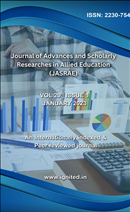Integrated Management of Meloidogyne incognita: A Review of Biocontrol Agents and Organic Amendments
Exploring the potential of biocontrol agents and organic amendments in managing Meloidogyne incognita
Keywords:
Meloidogyne incognita, biocontrol agents, organic amendments, nematode populations, nematophagous fungi, antibiosis, plant resistance, nematotoxic characteristics, soil properties, sustainabilityAbstract
The agricultural crops across the globe are under a significant threat from Meloidogyne, whichis a genus of root-knot nematodes. The present analysis centres on the comprehensive management ofMeloidogyne incognita. The present study assesses the efficacy of biocontrol agents and organicamendments in mitigating nematode populations. Several biological control agents, such asnematophagous fungi (e.g. Pochonia chlamydosporia) and filamentous fungi (e.g. Syncephalastrumracemosum), as well as bacterial agents (e.g. Bacillus and Pseudomonas species), have exhibitedpotential in mitigating nematode infestation. Bioagents utilize various mechanisms including antibiosis,competition, mycoparasitism, and induction of plant resistance. In addition, the utilization of organicamendments can aid in the reduction of nematode infestation and improvement of plant growth bymeans of their nematotoxic characteristics and facilitation of advantageous microorganisms. Theprocess of decomposing organic amendments results in the release of substances that impede thepenetration of nematodes and hinder their infective activity. Furthermore, these amendments promotethe proliferation of microorganisms that exhibit antagonistic behaviour towards nematodes, therebyhindering their reproduction. Organic amendments present a promising strategy for controllingMeloidogyne incognita through the improvement of soil properties, release of nematotoxic substances,and enhancement of plant resistance. Additional investigation is required to enhance the efficacy oforganic amendments in the context of nematode management approaches, and to evaluate theirenduring impacts on soil well-being and sustainability.Downloads
Download data is not yet available.
Published
2023-01-01
Issue
Section
Articles
How to Cite
[1]
“Integrated Management of Meloidogyne incognita: A Review of Biocontrol Agents and Organic Amendments: Exploring the potential of biocontrol agents and organic amendments in managing Meloidogyne incognita”, JASRAE, vol. 20, no. 1, pp. 200–205, Jan. 2023, Accessed: Jan. 13, 2026. [Online]. Available: https://ignited.in/index.php/jasrae/article/view/14289











